 How do ‘Normal’ phones work?
How do ‘Normal’ phones work?
Traditional telephony networks aka POTS (Plain Old TelephonySystems) are based on a network fabric using TDM (Time DivisionMultiplexing), a technology that’s been around for a longtime.
How does a POTS call work? When a call is established between two phone users, a “virtual circuit” is established between them and a certain amount of bandwidth reserved across that circuit (usually 64Kb/s). That bandwidth is reserved for the lifetime of the call, even if no-one is speaking. As the connection is synchronous, ie. when someone talks, the voice is sent across the network in the sequence that it was said. This occurs until the end of the call.
It’s different with VoIP
With the move to VoIP, voice first gets digitised, turned into small packets, which are then encoded into IP packets, in turn sent across an IP network. The packetisation actually adds overhead (takes longer and adds to the size), leading to VoIP sometimes utilising more network bandwidth than traditional telephony methods. Of course this can be mitigated by using modern CoDecs (the digitisers) which use more compression than traditional telephony. Unfortunately the more compression used, the lower the call quality. In a mobile network, voice is encoded at 13Kb/s (which increases to 20Kb/s+ when packetised – as an example of the overhead). People are used to this reduced quality, despite it being noticeably different from a phone call using a fixed-line.
 Using VoIP over the Internet is a hit and miss thing. We know the Internet is fantastic at coping with problems – if there are network errors, the data is re-routed around the black-spots, and when the error goes or traffic gets congested, it just re-routes the data somewhere else. It’s best to think of the Internet as a loose collection of around 30,000+ networks that happen to interconnect at various places.
Using VoIP over the Internet is a hit and miss thing. We know the Internet is fantastic at coping with problems – if there are network errors, the data is re-routed around the black-spots, and when the error goes or traffic gets congested, it just re-routes the data somewhere else. It’s best to think of the Internet as a loose collection of around 30,000+ networks that happen to interconnect at various places.
Where the re-routing works for general Internet traffic, it’s terrible for VoIP as there’s no guarantee that the VoIP data will arrive in an orderly fashion i.e. the first bit of traffic may go one way, then second another and the third another route completely. Each route will have be working at different speeds, so the 3rd piece of VoIP data may actually arrive at the destination first – imagine the third word of the conversation arriving before the first.
Packets arriving in a different order is expected on the Internet and it was designed with this in mind. IP can reassemble the data and put it all back in the right order, but to do so requires large buffers i.e long delays. Unfortunately for VoIP, delay not is something you want as that’s when calls break-up or crack and pop.
In the trade, the packets arriving at different times (relative to a clock signal i.e. like a metronome) is called Jitter.
 VoIP in an ideal world
VoIP in an ideal world
There are ways to get around this. Such as new technologies like IP/MPLS (IP/Multi Protocol Label Switching) which is a way of ensuring all traffic between two points goes the same way (with back-up routes, in case the primary one fails). It also allows for Quality of Service (QoS) metrics, so VoIP traffic can be prioritised over say Web traffic, minimising Jitter.
Many telecoms companies now run IP networks utilising IP/MPLS, but as they still interconnect over other, public connection points any quality metrics are lost. So as long as all your IP services come from the same supplier, you’re unlikely to be able to maintain QoS.
When does VoIP make sense/when not
VoIP does gives increased flexibility and anyone with a multi-site operation should consider it. If they’re currently paying bills to a telecoms company to transfer calls between sites, the use of VoIP is generally a no brainer, as it give a rapid payback for the added VoIP equipment required.
When to think twice about VoIP
Single site businesses, should be wary. Installing VoIP can consume significant resources when converting from a traditional system in particular using VoIP may require extensive reworking of an internal LAN – you don’t want your phone calls to stop when someone transfers a large file between their PC and the server.
It may be better to look at other options such as Carrier Pre Select (CPS) or Wholesale Line Rental (WLR) or simply another telecom’s provider whose rates are better.
 Security implications and therefore costs are a significant issue. The increase in network traffic that VoIP can bring can have other cost implications, such as ensuring firewalls are “chunky” enough to support the VoIP traffic.
Security implications and therefore costs are a significant issue. The increase in network traffic that VoIP can bring can have other cost implications, such as ensuring firewalls are “chunky” enough to support the VoIP traffic.
One area that isn’t often spoken about, but we feel is a big weakness of VoIP is the potential of all phone calls in and out of the site that are carried over VoIP being lost to a DoS (Denial of Service) attack. Protecting against attacks can be difficult, as the attacks may just look like remote workers trying to establish VoIP calls into the network.
Conclusion
VoIP isn’t a panacea. While it can offer savings and great flexibility, the choice shouldn’t be automatic. Look at the whole picture and work out if there really are savings to be made. If there’s no ROI (Return on Investment), then VoIP is an expensive new toy.
 If you’ve owned a few digital cameras or PDAs and switched brands a couple of times over the years, you’ll probably already have a formidable collection of non-compatible memory cards wasting away in your drawer.
If you’ve owned a few digital cameras or PDAs and switched brands a couple of times over the years, you’ll probably already have a formidable collection of non-compatible memory cards wasting away in your drawer. Much as we hate to give any kudos to yet another memory card format, that’s a mighty impressive capacity and offers enough storage space to turn mobile phones into fully fledged, iPod-worrying MP3 players.
Much as we hate to give any kudos to yet another memory card format, that’s a mighty impressive capacity and offers enough storage space to turn mobile phones into fully fledged, iPod-worrying MP3 players. It looks like the world is going blog crazy as the number of blogs online doubles every five and a half months, with a brand new blog being created every second.
It looks like the world is going blog crazy as the number of blogs online doubles every five and a half months, with a brand new blog being created every second. According to Technorati, around 2.7 million of those blogs are updated at least weekly, with something like 1.2 million total posts appearing every single day. New blogs are appearing at a rate of over 75,000 every day with an average of fifty thousand blog posts being recorded every hour.
According to Technorati, around 2.7 million of those blogs are updated at least weekly, with something like 1.2 million total posts appearing every single day. New blogs are appearing at a rate of over 75,000 every day with an average of fifty thousand blog posts being recorded every hour. It’s not all good news though, with Sifry revealing that “about 9% of new blogs are spam or machine generated, or are attempts to create link farms or click fraud.”
It’s not all good news though, with Sifry revealing that “about 9% of new blogs are spam or machine generated, or are attempts to create link farms or click fraud.” Although cameras are considered to be an essential part of modern mobile phones, a new study has revealed that only a tiny percentage of camera phone snaps are actually being stored or sent.
Although cameras are considered to be an essential part of modern mobile phones, a new study has revealed that only a tiny percentage of camera phone snaps are actually being stored or sent. “However, once they start using their new phones, they are turned off by perceived poor picture quality, slow network speeds, and the difficulty of creating and sending pictures. Our survey found that very few pictures actually make their way out of the handset to be shared with others,” he commented.
“However, once they start using their new phones, they are turned off by perceived poor picture quality, slow network speeds, and the difficulty of creating and sending pictures. Our survey found that very few pictures actually make their way out of the handset to be shared with others,” he commented. After seeing the dire quality of the pictures taken with our
After seeing the dire quality of the pictures taken with our  Consumers wanting to be able to take and send decent quality photos are hit by a double whammy: camera phones capable of taking high quality phones aren’t cheap, and the higher resolution files they create end up costing a bomb in network carrier costs. Best solution? Take along a ‘real’ camera and email it when you get home.
Consumers wanting to be able to take and send decent quality photos are hit by a double whammy: camera phones capable of taking high quality phones aren’t cheap, and the higher resolution files they create end up costing a bomb in network carrier costs. Best solution? Take along a ‘real’ camera and email it when you get home. Internet big boys Google and Skype have teamed up with two venture capital firms, Index Ventures and Sequoia Capital, to invest a mighty wedge into Fon Technology, a Spanish startup looking to build a global network of Wi-Fi hotspots.
Internet big boys Google and Skype have teamed up with two venture capital firms, Index Ventures and Sequoia Capital, to invest a mighty wedge into Fon Technology, a Spanish startup looking to build a global network of Wi-Fi hotspots. For Google and Skype, a deal with FON makes their web-based services more ubiquitously available, with developers gaining access to a new platform for creating and delivering services on a global scale.
For Google and Skype, a deal with FON makes their web-based services more ubiquitously available, with developers gaining access to a new platform for creating and delivering services on a global scale. “As we continue to grow, we will attract consumers for all three foneros categories and achieve our goal of creating a global WiFi nation. This is a great opportunity for ISP’s, bloggers, developers, early adopters, consumer electronics manufacturers and the ‘average Joe or Jane’ with a WiFi connection to make money by letting other foneros connect to the Net safely and simply,” he continued.
“As we continue to grow, we will attract consumers for all three foneros categories and achieve our goal of creating a global WiFi nation. This is a great opportunity for ISP’s, bloggers, developers, early adopters, consumer electronics manufacturers and the ‘average Joe or Jane’ with a WiFi connection to make money by letting other foneros connect to the Net safely and simply,” he continued. It’s been spluttering and wheezing in its sick bed for what seems like an eternity, but the latest figures from research firm IDC confirm that the prognosis isn’t good for the Personal Digital Assistant (PDA).
It’s been spluttering and wheezing in its sick bed for what seems like an eternity, but the latest figures from research firm IDC confirm that the prognosis isn’t good for the Personal Digital Assistant (PDA). Although a bright Christmas period saw sales grow 37.6% over Q3, the trend remains resolutely downward, with the declining market segment driving PDAs into a market niche.
Although a bright Christmas period saw sales grow 37.6% over Q3, the trend remains resolutely downward, with the declining market segment driving PDAs into a market niche. But don’t go ordering flowers for the PDA funeral quite yet, as IDC research analyst Ramon Llamas insists that it’s not all over for the PDA market, with plenty of smaller vendors remaining committed to a more niche PDA market.
But don’t go ordering flowers for the PDA funeral quite yet, as IDC research analyst Ramon Llamas insists that it’s not all over for the PDA market, with plenty of smaller vendors remaining committed to a more niche PDA market. With Palm winding down its PDA business and concentrating on its Treo smartphone range, Nelson argues that Palm will have difficulty competing against deep-pocketed rivals like Dell and HP who are currently ploughing big R&D budgets into similar products.
With Palm winding down its PDA business and concentrating on its Treo smartphone range, Nelson argues that Palm will have difficulty competing against deep-pocketed rivals like Dell and HP who are currently ploughing big R&D budgets into similar products. After trying to cheat its way to the top of the search engine pile, BMW has been dropped from global search engine, Google.
After trying to cheat its way to the top of the search engine pile, BMW has been dropped from global search engine, Google. As he explains in his blog, search engine ‘bots’ arriving at the BMW site would see a page full of keyword-loaded text, which had been optimised to ensure a high search engine ranking.
As he explains in his blog, search engine ‘bots’ arriving at the BMW site would see a page full of keyword-loaded text, which had been optimised to ensure a high search engine ranking. BMW now have the dubious honour of becoming one of the highest profile companies to have a website effectively blacklisted by Google, by having their all-important PageRank reset to Zero (German camera manufacturer ricoh.de are also set to be delisted).
BMW now have the dubious honour of becoming one of the highest profile companies to have a website effectively blacklisted by Google, by having their all-important PageRank reset to Zero (German camera manufacturer ricoh.de are also set to be delisted). Now holding the record for the fastest-selling debut album in the UK, the success of young British indie-rockers Arctic Monkeys shows how the Web has changed both the way in which bands promote and market themselves and how people find new music.
Now holding the record for the fastest-selling debut album in the UK, the success of young British indie-rockers Arctic Monkeys shows how the Web has changed both the way in which bands promote and market themselves and how people find new music. For less than the cost of a handful of flyers, bands can set up their own Websites, offer free downloadable tunes, sell merchandise, maintain free email mailing lists and invite a dialogue with their fans.
For less than the cost of a handful of flyers, bands can set up their own Websites, offer free downloadable tunes, sell merchandise, maintain free email mailing lists and invite a dialogue with their fans. With a growing fanbase clambering for more, it wasn’t long before record companies were begging to sign up the band, and last week’s album release on Domino Records saw the Artic Monkeys record-breaking leap up the charts.
With a growing fanbase clambering for more, it wasn’t long before record companies were begging to sign up the band, and last week’s album release on Domino Records saw the Artic Monkeys record-breaking leap up the charts. How do ‘Normal’ phones work?
How do ‘Normal’ phones work? VoIP in an ideal world
VoIP in an ideal world Security implications and therefore costs are a significant issue. The increase in network traffic that VoIP can bring can have other cost implications, such as ensuring firewalls are “chunky” enough to support the VoIP traffic.
Security implications and therefore costs are a significant issue. The increase in network traffic that VoIP can bring can have other cost implications, such as ensuring firewalls are “chunky” enough to support the VoIP traffic. Love music? Love iPods? You might
Love music? Love iPods? You might  Couple of content quickies –
Couple of content quickies –  ?The tumbrels are resounding for enemies of Google European head, and former T-Mobile boss, Nikesh Arora, following the “disappointing” financial results. In fact, the results were trivially down, but that was enough, and his head will be anxiously sought by Google in the US, say our stray packet interception team.
?The tumbrels are resounding for enemies of Google European head, and former T-Mobile boss, Nikesh Arora, following the “disappointing” financial results. In fact, the results were trivially down, but that was enough, and his head will be anxiously sought by Google in the US, say our stray packet interception team. And the City doesn’t like people it can’t cut down to size. Give them an excuse, and they will jump on you, which is what happened. That $40m is the excuse they’ve been waiting for. “Misled us with the forecast!”
And the City doesn’t like people it can’t cut down to size. Give them an excuse, and they will jump on you, which is what happened. That $40m is the excuse they’ve been waiting for. “Misled us with the forecast!”